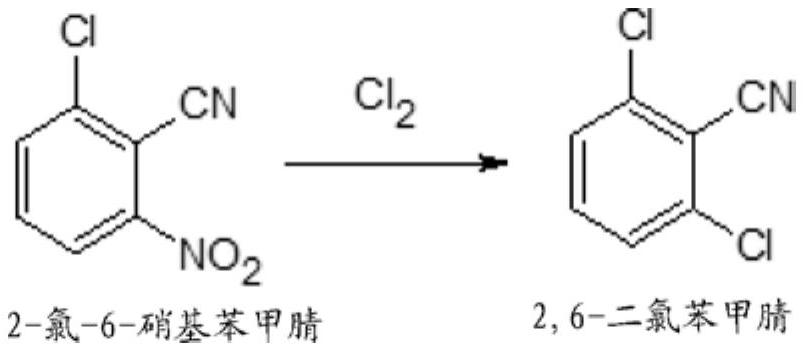Process for preparation of 2,6-dichlorobenzonitrile
A technology of dichlorobenzonitrile and chlorobenzonitrile, which is applied in the field of preparation of 2,6-dichlorobenzonitrile, and can solve problems such as unfavorable industries, limited sources of 2,6-dichlorotoluene, and large investment in equipment
- Summary
- Abstract
- Description
- Claims
- Application Information
AI Technical Summary
Problems solved by technology
Method used
Image
Examples
Embodiment 1
[0084] This method is the following example, which demonstrates the effect of temperature on the reaction.
[0085] Table 2
[0086]
[0087] In the above examples, nitrosylsulfuric acid was produced and isolated in solid form from the sulfuric acid scrubber in molar equivalents to released NOx.
Embodiment 2
[0089] With overhead stirrer, TP, powerful column with concentrated H in oil bath 2 SO 4 In the 1 liter 4 neck RBF of the scrubber, charge 2-chloro-6-nitrobenzonitrile and increase the temperature. Chlorine gas was then slowly purged into the flask to obtain a consistent rate.
[0090] The 2,6-CNBN conversion rate of the obtained reaction material was analyzed to be ≥99%; 2,6-dichlorobenzonitrile was observed to be 73-80%; TCB was observed to be 9.4-10%.
[0091] After the reaction was completed, the reaction mass was cooled to 100° C. and diluted with monochlorobenzene, neutralized by washing with 10% aqueous sodium carbonate solution, and decolorized with activated carbon. The decolorized 2,6-dichlorobenzonitrile solution was refluxed in methanol and crystallized at 10 °C, filtered and dried in a vacuum oven.
[0092] table 3
[0093]
[0094] These examples demonstrate that DCBN can be denitrochlorinated by CNBN at 180-190°C in 71-76% yield and >98% by utilizing co...
Embodiment 3-6
[0096] 2-Chloro-6-nitrobenzonitrile (obtained from the method described in Example 7) was charged to an RBF equipped with concentrated sulfuric acid and caustic scrubber, overhead stirrer and electrically heated oil bath, and The temperature rose to 195°C. Chlorine is then purged at varying rates for 10-16 hours in a controlled sequence. The resulting reaction mass was analyzed for 2,6-CNBN conversion to >99%, and 2,6-dichlorobenzonitrile was shown to be 92-94%. Dilute the reaction mass with monochlorobenzene at 100°C; neutralize by washing with 10% aqueous sodium carbonate; decolorize with activated carbon.
[0097] The decolorized 2,6-dichlorobenzonitrile solution was refluxed in methanol and crystallized at 10 °C, filtered and dried in a vacuum oven.
[0098] Table 4
[0099]
PUM
 Login to View More
Login to View More Abstract
Description
Claims
Application Information
 Login to View More
Login to View More - Generate Ideas
- Intellectual Property
- Life Sciences
- Materials
- Tech Scout
- Unparalleled Data Quality
- Higher Quality Content
- 60% Fewer Hallucinations
Browse by: Latest US Patents, China's latest patents, Technical Efficacy Thesaurus, Application Domain, Technology Topic, Popular Technical Reports.
© 2025 PatSnap. All rights reserved.Legal|Privacy policy|Modern Slavery Act Transparency Statement|Sitemap|About US| Contact US: help@patsnap.com



